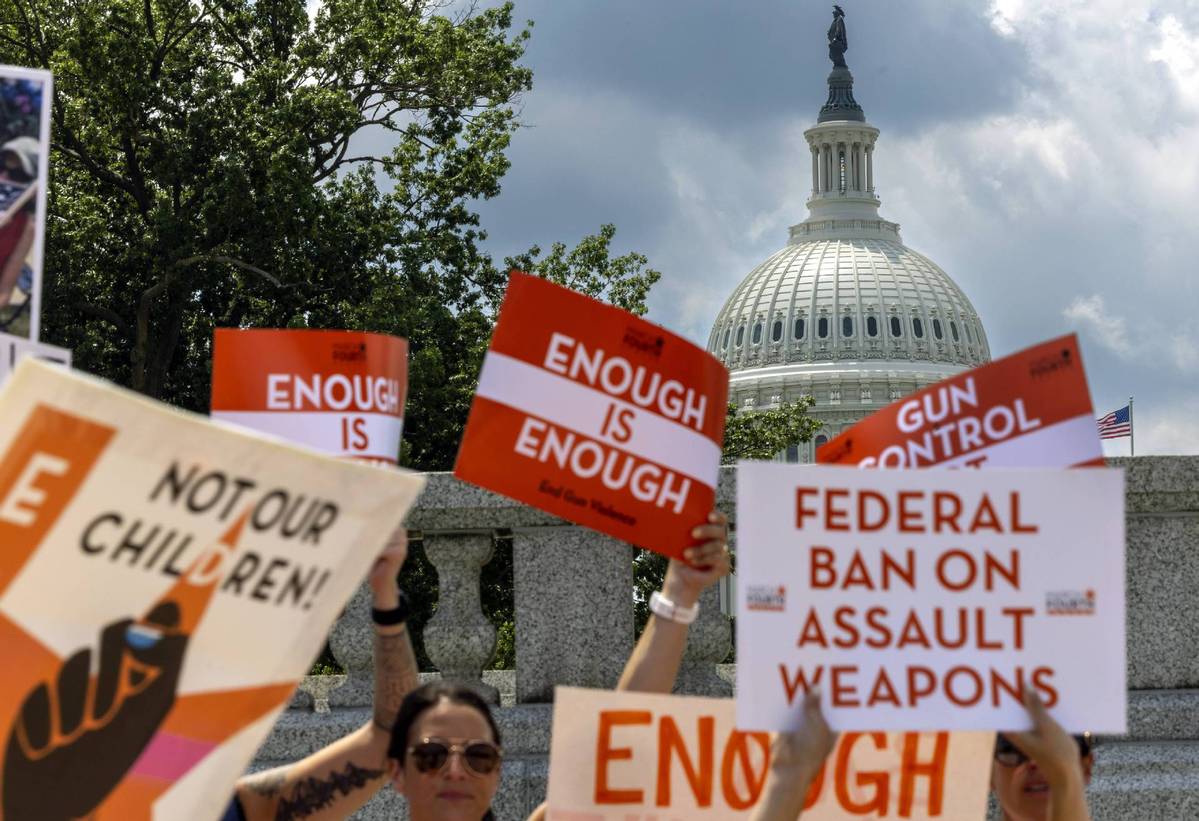US schools take hard-line approach to shootings
By AI HEIPING in New York | China Daily | Updated: 2022-09-09 07:15

Mass opposition
Polling has shown that teachers are overwhelmingly opposed to being armed in the classroom.
In an American Federation of Teachers survey of nearly 4,000 K-12 teachers in Texas, 76 percent answered "no" when asked, "Do you want to be armed?"
In Virginia, a statewide public opinion survey conducted by Patch News found 83 percent of respondents were opposed to teachers being armed. Those who favored allowing teachers to carry weapons cited lengthy police response times to an active shooter event-a critical factor in the Uvalde massacre.
While much of the effort to make schools safer has centered on hardening security, experts said schools should focus on softening to support students' social and emotional needs.
Odis Johnson, from Johns Hopkins University's Center for Safe and Healthy Schools, said, "Our first preventative strategy should be to make sure kids are respected, that they feel connected and belong in schools."
There has been a significant increase in the willingness and ability among schools to hire mental health support professionals, as much of the funding is coming from pandemic federal aid. According to the White House, with the help of federal COVID-19 relief money, schools have seen a 65 percent rise in their number of social workers and a 17 percent rise in counselors.
While schools in New Jersey have armed guards, the state also is taking another approach to thwart possible shooting incidents-"threat assessment teams". A month after the Uvalde shooting, a bill was adopted and signed into law by Governor Phil Murphy requiring all public school districts in the state to establish these teams for the 2023-24 school year.
The teams are intended to enhance schools' ability to help identify risks before an act of violence occurs, and they will identify students who might engage in violence or other harmful activities. To prevent targeted violence in a school, the teams will also assess and deliver intervention strategies to manage the risk from students who pose a potential safety hazard.
Each team will consist of a safety specialist, a principal or other senior administrator, a school resource officer, a teacher and a psychologist, a counselor, and a school social worker or school employee with expertise in student counseling.
Laurie Doran, director of the New Jersey Office of Homeland Security and Preparedness said, "We are not only first responders, we are first preventers."
Cathy Bolto, coordinator of a network of parents and community members serving students, said that while threat assessment teams might reduce potential risks with early identification, children who are determined to be "threats" should be handled in a "nurturing way, not with force or aggression by law enforcement."
In Texas, following the shootings in Uvalde, the state transferred another $105.5 million to support additional school safety and mental health initiatives through August 31 next year, on top of existing funds for school security measures.
Most of the money will be spent on such measures. About $50 million will be used to buy bullet-resistant shields, while $17.1 million is earmarked for school districts to purchase silent panic-alert technology.
In Uvalde, many students fear returning to school, and some have chosen to learn online. At the request of the Uvalde school district, to help students, parents and faculty members feel safe as they return to school, the state announced early last month that it would provide more than 30 law enforcement officers to schools for the new school year.
Across the state, many school districts are adopting various safety measures. In Dallas, the second-largest school district in Texas, students must wear clear or mesh backpacks so that authorities can detect illegal items such as guns.
Some school districts have gone further. On Aug 22, the Kilgore school board unanimously approved a plan to allow district employees to voluntarily carry a concealed weapon on campus. This school system in northeast Texas has about 4,000 students.
Andy Baker, superintendent of schools for Kilgore, said, "The intention is to provide one more level, one more layer, in the possibility that we ever have a severe act of violence on one of our campuses."
School faculty members interested in taking part in the plan will need to meet prerequisites to be considered. Few people in the district will know the identity of these "guardians".
In Uvalde, Adam Martinez has decided to let his children choose online schooling for the coming year. It wasn't his first choice, but they are still scared, he told The Texas Tribune.
"I was telling my son, 'there's gonna be a tall fence, and they're gonna have state troopers on all the locations,'" Martinez said. "And he told me, 'Who cares if there's cops? They're not going to do anything anyway, they're scared'."
May Zhou in Houston, Minlu Zhang in New York and Yinmeng Liu contributed to this report.
























